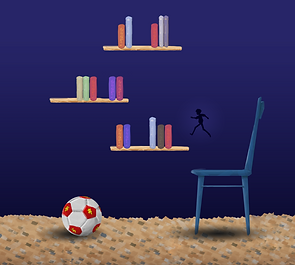
Breakdown
Download
Prototype
A 2nd Game Art and Design solo project (July 2016) that I took further and developed for a exhibition at one of Ireland's biggest gaming conventions.
Shadow came around from a conversation with my mother and we were talking about grief and I thought that maybe this could be a topic I could try and address. So I based it around the relationship between my grandfather and me. In the end, it worked as a way of dealing with grief in my own life. Pursuing this game I would certainly want to address the topic more within the game but for now it's more of a mechanics trial run with the main character Jonas's Grandfather being his story of grief.
I wanted to start the breakdown with literally the initial doodles and concepts I made for the game. So people could see that they aren't pretty and far from perfect, in the hope that it might break a stigma I see with a lot of people who are afraid to just start because they "aren't good enough". Some of these are digitally done and some were just scratches at the bottom of a page. Again proving you don't need amazing hardware or software to get started, just and pen and a page (in some cases a pen is better than a pencil because it's more finite and stops you from rubbing out all the time and gets you doing things).




Now ramblings aside, you can see from the sketches (or at least i can) that I wanted to use the shadows of objects to navigate the levels and that the player had control of these objects and created a level in a way they thought it should/could be completed.
From this I actually switched off all the lights in my room and put a single lamp on and genuinely started to hold up objects in front of it and moving them round to see what weird shapes could be created. I remember the moment I saw the shadow of my fish on the wall and my brain lit up with ideas of pets and other creatures. Then seeing the arch in the fish tank and thought what if the fish could get caught, or better yet, what if the character could get caught in these places. So this brought on the list of things like chairs and tables that the shadow form could get stuck within but still lit up.
Then came the ideas of moving lights, swinging lights, reflections, pushing lamps on skateboards so the shadow could remain lit as he ran.
My point here, is I didn't have all these ideas before I started making the game, but that I stumbled upon them once I had my main mechanic realised. So i want others to allow that breathing room and freedom to let their idea grow once they main mechanic is decided. The difficulty comes when you have too many ideas and you have to learn to strip the good from the bad. But more importantly strip the achievable from the unachievable especially if your working with a small team.
"..realise what's achievable.. ..especially if your working with a small team."
"..share your work with others to get as many opinions as possible."
Now an interesting point to keep in mind is style. This may not see important but it can determine a lot with whats achievable in the game.
For example; one of the first character designs I did was the boy on the far right of the line up. A very dark and sketchy look. I went down this path because I felt the darker moody style would work well in a game about grief. This proved to be an issue when I thought about it more because it meant my objects in the room would have to follow this sketchy style too and meant their shadows wouldn't be 100% correct and might lead to people getting confused with the shapes they could make. So I had to scrap this design but I liked the proportions I had outlined with this design it also led me to think about my characters age. Again with the theme of the game being grief, it meant to character had to be old enough to know about lose. However they couldn't be to old, otherwise I felt the player wouldn't sympathies with the character and just shrug off the fact that they were hurt or being tormented.
With all this in mind, I thought that maybe an illustrative style might work, Making the game feel more like a story book. Following this thought I landed on two designs I liked, the first boy in the line up and the third. A choice was easily made from these two because even though the third style was my favorite everyone told me that it look a lot like Broken Age and I didn't want to fall in the bracket of "oh that Shadow game like Broken Age" so I went with the first design to try keep some sense of individualism. This raises the topic to share your work with others to get as many opinions as possible, because it will only lead to improving your work. You will be surprised with ideas people have even if they have never played video games.





The third image shows what happens if an objects is effected by 2 light sources. We still find the distances between the lights like normal (marked with red) but we then take their percentages and compare them to each other to find which light source is the dominant light. The closer the light is to the object the more dominant it is as it's light is closer and effects the object more than a light source that would be further away.
Since I have spoken quite a bit about the art and style of the game. I thought it best to talk a little on the technical side of things. So here you can see what Shadow looked like for 90% of it's life cycle. These black squares resemble the different shapes and objects in the room. The Lighter blue squares being their shadow and the white circles the light that the players controlled.
I found it was key to keep the game as minimal as possible at the start so that I could really develop it's core mechanic, controlling shadows.
To breakdown how the shadows work;
The light sources only effect an objects shadow if the lights collider overlaps the objects. You can see in the first image that the circle (light) isn't hitting any objects so no shadows are being effected.
The second image shows how the circle is overlapping two objects, this is when the fun begins. So first we need to find out what the max distance of the light can be from the object, call that 100%. Then we look at the distance between the lights center and the objects center (shown here by the red line). We then work what proportion this is to our original 100%. For example purposes lets say that the distance in image 2 is 60%. This means we offset the shadow from 60% from its starting position (this distance marked by the green line). With the light overlapping 2 objects this algorithm is applied to both objects effected.
Dynamic/Intractable Shadows






With the mechanic in place and working correctly we could being designing the level. Now an issue every developer will have with their game is that they will become very accustomed to its bugs and quirks so it's important again to get as many people to play it as you can so you can find these pit falls and fix the issues you might be blind to. One issue I found for myself, was I wanted the player to feel like they were choosing their path and choosing where they could go in the room. So I started them in the middle and let them walk anywhere they wanted. The issue with this was that people often felt overwhelmed with where to go and I had to baby sit them through certain areas. The diagram above shows the players path round the room when I first laid it out. There was no flow or natural progression, it was very all over the place and with no rest.


After taking a step back to look at the level I did some Tetris, re-positioning objects and objectives to allow for a better flow of progression. Starting the player with the sofa, meant they could wrap their heads around the shadows and light control in a safer environment. Then came the "awareness of objects around the room challenge" and for them to realise they can move things to allow them access to areas (the chair). Lastly was a challenge of their knowledge, can you manipulate the shadows of the book shelves correctly to get up them. This layout worked far better and shows a nice line of progression.
This only came about by play testing and letting people break the game so I could figure out where to fix. There is still a lot I want to do with the game and this is very much a jumping off point in developing it but I hope you have found a few things that might help. Feel free to message if you have any further questions, thanks for reading.
"..letting people break the game so I could
figure out where to fix it."


